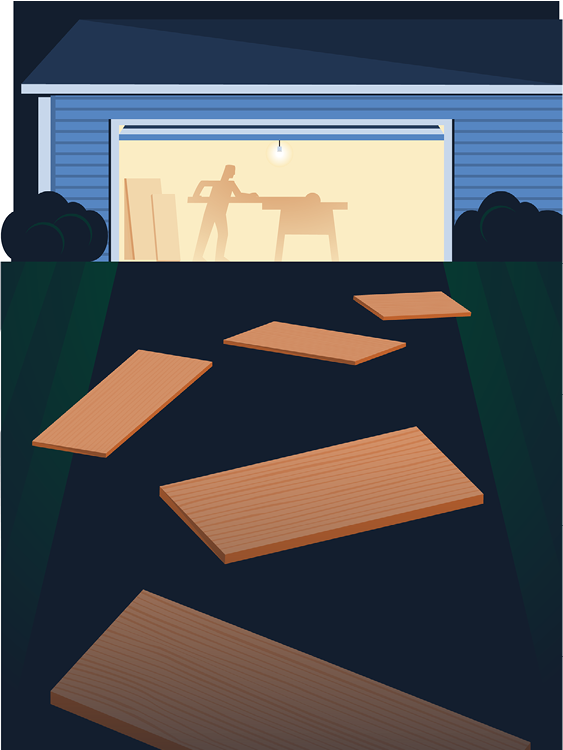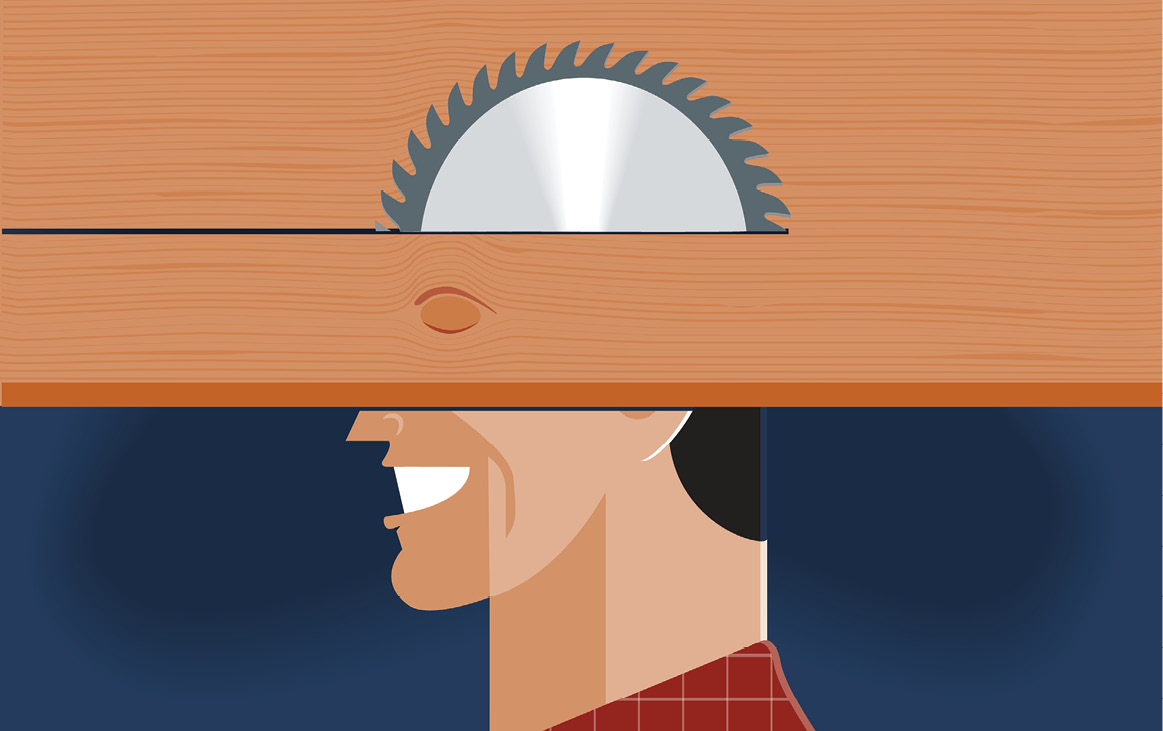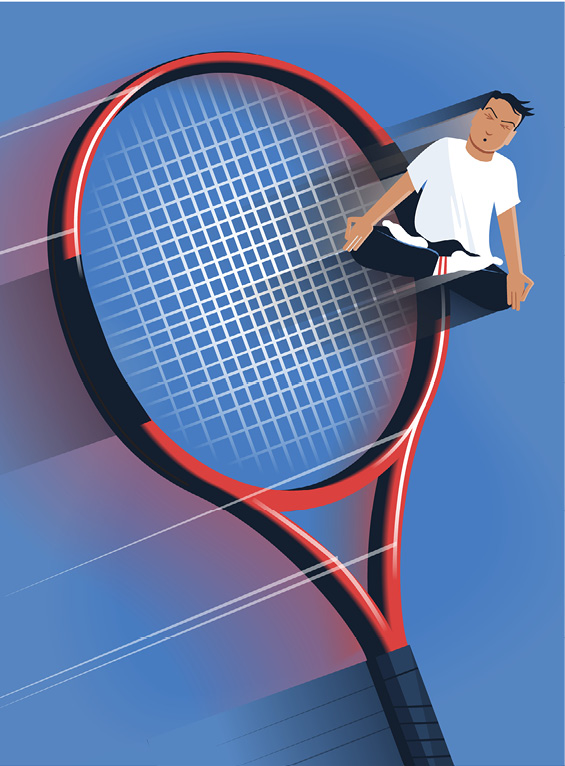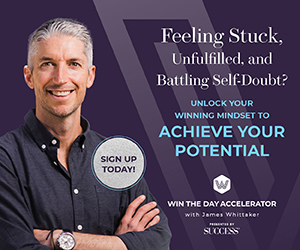This was supposed to be relaxing. I thought as I prodded my tongue through a mouthful of blood and gore to check for missing teeth. Back molar: still there. Crown: intact. Bicuspid: check. My surprise grew tooth by unlikely remaining tooth. Every pearly white was present and accounted for.
It should have been obvious that a table saw with the power of 5,000 revolutions per minute could sling a 7-by-16-inch piece of plywood at tremendous velocity. In fact, the chunk of scrap wood still had so much force after it ricocheted off my face to slam into the laundry room door and rattle it in its frame with a bang loud enough to startle my wife, Emily, a few rooms away.

JOHN TOMAC
I went inside and rinsed my mouth, spitting clots of crimson flesh into the sink while Emily put together an ice pack. Once the bleeding slowed, we examined the damage. My lower lip was torn all the way through in an L-shaped laceration near the corner of my mouth. The chances of the tissue knitting itself back together in alignment without stitches looked slim, and my confidence in the DIY ethos was at its nadir, so we opted against home remedies. Also the prospect of painkillers sounded pretty good right then.
In the emergency room waiting area, I tried to think positively. The injury could have been worse. Had I not been wearing a cotton dust mask, the skin would have been ripped much worse. Half an inch higher and the wooden missile would have broken half the teeth in my mouth. Three inches higher and it would have shattered my plastic safety glasses and hammered the shards into my left eye. Two feet lower and my chances of having another child would be approaching zero. Still, I sulked.
![]()
My woodworking misadventure began a couple weeks earlier, when a Business Insider headline caught my eye. “Journalists drink too much, are bad at managing emotions, and operate at a lower level than average, according to a new study.” The research, led by London-based neuroscientist and life coach Tara Swart, Ph.D., found that journalists’ executive brain function is lower than that of other groups. Culprits included too much coffee, junk food and alcohol, and not enough sleep or healthy food. Low executive function negatively affects one’s regulation of emotions, problem-solving skills and creativity, among other capabilities. Another area in which journalists scored poorly was silencing the mind: the ability to focus, to think with clarity and without distraction, and to avoid worrying about the future and regretting the past.
Related: Food, Sleep, Exercise: Why You Seriously Need All 3 to Be Successful
You could say it hit home. It read like a list of things I wanted to improve about myself. I consider any more than six hours of sleep a luxury. My diet consists largely of red meat and junk food washed down with coffee in the a.m. or beer in the p.m. And it feels like half of my conscious thoughts were given to rumination over past mistakes, anxiety about future ones or unnecessary negativity—to wit, the internal chicken-and-egg debate of whether I picked a career in journalism because I’m so flawed, or whether journalism made me this way.
The remedy to so many of the problems Swart’s study examined, the very problems I was beginning to identify as chronic in my life, seemed simple enough: Get more sleep and more exercise, eat better, drink less and stay hydrated. I wondered how it would improve my life if I put conscious intent into these practices. My hope was it would help me stay on task at work and be a more efficient editor and more prolific in my writing. Perhaps the benefits would carry over to my home life—being more present for my family and getting more done around the house.
There were definable benefits I was looking for: better working memory, time management, emotional control and creativity. But how would I measure them? How would I know it was working? How would I keep it up?
![]()
For the first day of this new commitment to focused mental improvement, I chose to go about my routine normally while taking note of my actions and feelings. My wife and I had recently pledged we would drink only on days that we exercised, so I had already been getting more exercise. For the purposes of our drinking agreement, I decided walking the dog, Izzy, counted as exercise. Keeping my intake at or below the study’s recommended 14 drinks or less per week sounded like an adjustment but not a big one.
After Izzy and I got home from our constitutional, I dropped a few ice cubes into a rocks glass and filled it about halfway with whiskey (perhaps my definition of a single drink was a tad liberal). Dinner consisted of leftovers, almost all of it meat, including half of a hamburger on a butter-soaked bun. Emily and I stayed on the couch after we finished eating and watched replays of The Office for hours. I didn’t make any realistic suggestions of other ways to spend our time, but I still didn’t enjoy the dull routine. Then I resented myself for not doing anything more productive. And I was mad at myself for being so hard on myself. Maybe my real problem was guilt and self-criticism, I thought.
Related: 7 Breakthrough Steps to Shed Negative Habits
The next day was a setback: no exercise and no moderation on my food or drink intake. It was just a day on autopilot—a thoughtless shuffle toward the finish line that was bedtime, interrupted only by arguments with my wife over some perceived slight that in hindsight was an almost textbook case of projection. That night I laid awake, sleepless and guilt-ridden that I’d failed so early in the experiment.
I determined to do better the next day, making a conscious effort to be productive at work, limiting my distractions, taking breaks to let my brain rest and doing my best to tackle tasks in a logical order of priority. A glass of cold drinking water left my desk only for refills. As quittin’ time approached, I felt calm and satisfied with what I’d accomplished—a rarity for me—and I planned a meal with chicken and green vegetables rather than beef and potatoes.
At home, I had a good run with Izzy and refreshed afterward with a cold brewski. Even as I poured my second beer while cooking, I knew I’d have a third. But I was in a good mood, and the kids, who spend half of each week at their mother’s and the other half with Emily and me, would be with us for the next few days. We had a fun family game night after dinner, and the extra drink felt celebratory rather than like my habitual reward for making it through another day at the office.
![]()
In the next few days, my definition of exercise got looser and looser, but I set out to do things that I thought of as being mindful. I didn’t know precisely what mindfulness meant, though. It sounded like a buzzword that caught on after some self-appointed guru repackaged a Buddhist practice and sold it in workshops. Yet I have always felt calm while doing physical, mindless tasks like yard work and home-improvement projects—when I can let my thoughts wander and easily shoo away anxieties that hover like unwelcome mosquitoes. Months ago my wife asked me to build a cabinet to hold our stereo system, record player and albums. I finally started, sketching a plan for an open trapezoidal design with a sort of mid-century modern look. Other than the angle cuts and the pocket hole joinery, the latter of which I’d never tried, it looked straightforward enough. It was a simple design, basically a box. What could go wrong?

JOHN TOMAC
The work was slow but peaceful. I cut three of the pieces correctly but screwed up the fourth by cutting with the board upside down, the angle of the cut leaving it too short for my plan. With no desire to make another trip to the hardware store, I spent a couple relaxing evenings in the garage hypnotized by the blur of the rotary sander as it skimmed across the surface of the three good pieces, leaving them smoother and smoother with each pass.
I bought a replacement for the fourth board a few days later, and I promptly made the same mistake, cutting it upside down, the angle again leaving it too short to recut correctly. The clatter of the ruined board tumbling across the driveway wasn’t as satisfying as I hoped when I hurled it in frustration—just a couple of wooden clunks. The thought of going to the hardware store again nauseated me, so I sent my daughter to buy yet another piece.
When I finally cut that cursed fourth piece, my table saw mishap occurred. At the emergency room, nurse after nurse came to my curtained-off section of the triage area, asking what happened. I chose to believe they were laughing with me because my recounting of the story was so clever and self-deprecating, not at me because of what an unusually idiotic mistake it was. The physician’s assistant who stitched me up did a great job.
I was making some progress—saw mishaps and messed-up boards aside—but my negative thoughts lingered. The night of the incident, as I laid awake while my entire face throbbed, I replayed the macho way I’d minimized the pain I was in and how I consequently didn’t get the stronger painkillers I’d hoped for. If only I had said the discomfort was a seven out of 10, not a five or six.
In short, I was applying this self-improvement plan somewhat haphazardly. My call with Swart was scheduled for a few days later. It couldn’t come soon enough. I needed help.
![]()
Our conversation led me to a few revelations.
One surprise was that the younger people in her study tended to drink less. They did more binge drinking, but it was the older ones who had fallen into the habit of coming home and having a glass of wine after a stressful day.
“I would encourage people to rise from non-conscious to consciously asking why you do something, because then that gives a bit more choice,” Swart says. “Do I really need that extra glass of wine? Or do I really need to eat that cookie?”
Not so surprising was how one’s attitude toward change had significant impact on their overall function. For example, the younger journalists from her study saw the digitization of their profession as positive whereas some of the older ones saw it as a threat. Of course, the older ones who adapted to change with a positive mindset functioned better.
Related: 7 Practical Tips to Achieve a Positive Mindset
“The brain doesn’t like anything new, any change,” Swart says. “That’s why you need really good executive function: to be able to override some of those things that make you emotional, that make you biased, that make you less willing to collaborate.” She explained how doing or learning new things strengthened pathways in the brain that improved its overall function, as did even just 12 minutes of mindful meditation per day.

JOHN TOMAC
I asked whether taking up new hobbies or physical activity was an example of mindfulness—tennis and woodworking, for example, which just happened to be a couple of recreations I’d begun recently.
“They wouldn’t fall into mindfulness,” Swart says. “That would fall into what I call me-time.”
Me-time is also important, she says, but it wasn’t a focus of her study. Mindfulness would include meditation, though, and she recommended a couple of apps that would guide me through a session. The irony that I would meditate using a smartphone or computer—both of which essentially serve as pipelines to a vast reservoir of stressors and distractions—was not lost on me. But mindfulness could also include a quiet walk through the park, or doing other things thoughtfully.
![]()
Every day, I wrote “meditate” on my to-do list. And every day I put it off in favor of trying to improve myself with something tangible: eating a Swart-recommended brain-friendly food like salmon or avocado, chugging water by the pint, going on a run at the nearby city park, increasing the resistance on my gym’s chest-press machine and practicing my tennis serve. In the moments when it seemed meditating would be most beneficial, such as trying to come up with a solution to a problem or make an important decision, my brain would tell me to get back to the immediate task and not linger on some pseudo-spiritual waste of time. And I would resume working for a few minutes before an online distraction came along and I found myself reading another political think piece, looking at a funny dog picture or watching a GIF over and over.
It was becoming obvious I wasn’t just putting off the mindfulness meditation but actively avoiding it. The idea repulsed me for reasons I couldn’t understand.
But one night I went to my home office determined to try it, and promised myself that I would not leave until I meditated. I searched the web for guided meditations and didn’t get past the first few pages of results. The videos were so corny I was embarrassed at the prospect of my wife walking in and catching me with them onscreen. The guides gave vague instructions like “be confident and visualize achieving your goal.” Eventually I found one intended for mindfulness, not goal achievement. The voice telling me over and over to note how my chair feels and listen to my breathing wavered between dull and creepy. When an intrusive thought came, I was supposed to acknowledge it and dismiss it, whatever the hell that meant. During the breaks from the repetitive instructions, dull ambient music played, and I let my mind wander until I was dreaming, half-asleep in the chair but upright.
It didn’t matter how I was meditating, as long as a I was intentional about it.
The next morning I tried it again without the computer or the music, sitting cross-legged on the floor. I listened to the in and out of my breath and felt my back get sore, my knees stiffen. As I sat, my thoughts went from my breathing to thinking about how I could do this same meditation thing while also achieving something concrete—maybe exercising, say, while being mindful.
Then it hit me. I couldn’t allow myself to just sit still and do nothing. It was the same as how I could never just sit on the couch and watch TV with my wife without the feeling that we could be doing something more meaningful or productive. I am not a spiritual person, but the realization felt profound, like the kind of revelation people talk about after psychedelic experiences or when they say God or the universe gave them a message. Perhaps the best way for me to meditate or find mindfulness was to do it while working on something like the record cabinet. It didn’t matter how I was meditating, as long as a I was intentional about it.
Related: I Actually Tried Meditation for 30 Days—This Is What Happened
![]()
When the last day of my experiment in intentionality and mindfulness came, I hadn’t picked up a power tool since the accident. Emily, the kids and my friends teased me that I’d developed a phobia. It wasn’t that, really, it was just that there were other things around the house that were more pressing than finishing the record cabinet. I needed to finish reading a book before interviewing its author for a story I was working on. I also really wanted to see Wonder Woman before it left theaters.
When a long holiday weekend arrived, I was out of reasons to procrastinate on the woodworking project. I tried to casually stroll into the garage and get back to it as if nothing had happened, but my heart rate went up when I surveyed my progress and saw I had one last cut to make on that damned fourth board.
Lacking a full helmet and face shield, I made do with a fresh dust mask and a sturdier pair of safety goggles. I measured twice, triple-checked that the board was right-side up, and tightened the guard rail for the cut.
Apparently you can botch something only so many times in a row, because this time the cut was a success. The board was a perfect, or at least close enough, match to its counterpart. The waste piece fell behind the saw, unlaunched.
I pieced the whole thing together before staining and finishing it. Pocket hole joinery would be a new skill to learn, and I was beginning to doubt it would be as simple as the instructions on my new jig kit made it seem. But for now, I could just sand the boards, sand them and sand them, letting my thoughts drift in the repetitive task.
When the boards were as smooth as they were going to get, I checked the clock and was surprised to see how much time had slipped away. The assembly could wait until another day. My wife was on the couch waiting for me to join her. I needed to sit down and do nothing at all.
![]()
I completed the cabinet a few days later, sanding the corners enough to hide imperfections in the joints, staining it a deep gunstock orange and glossing it with a few coats of satiny finish. To my relief, it did not collapse under the weight of our record collection. In fact I’m sufficiently proud of it that I try to nonchalantly steer guests toward the living room where it resides, hoping they’ll ask about it.
Months later, my lip has healed with only a faint scar. My wife turned the errant scrap-wood projectile into a warning sign, stapling the bloodied dust mask to it and writing “Safety First Or Else” on it. It hangs above my garage workspace, where I’m planning to build an entertainment center.
Although I still struggle with some of the practices I tried to implement, I stuck with most of them, and the past few months have been rather productive. I even still force myself to meditate occasionally, and I am getting better at ignoring the interior monologue telling me to do something productive. Most important, I allow myself to relax—just not when using power tools.
Related: Pick Up These 6 ‘Me’ Habits to Be a Better You
This article originally appeared in the January 2018 issue of SUCCESS magazine.


